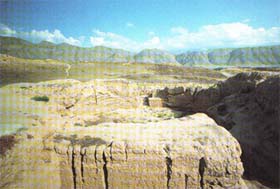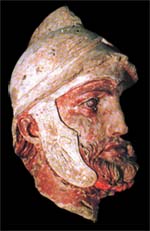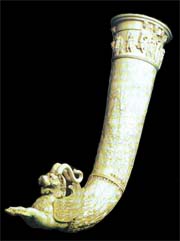NISAThe name Nisa came to us from the depth of millenaries and its meaning had been already forgotten in the Middle Ages. Meanwhile it was mentioned in cuneiform texts of II millennia BC left by the early civilizations of Iran, as well as in Avesta – the sacred book of Zoroastrians. There were written about the area of Nisayeh through which Iranian tribes moved to the south-west, about its green pastures whereon the famous in whole Ancient East horses were bred. Nisa is situated in the outskirts of Bagyr village (to the west from Ashgabad) and consists of two impressive archaeological sites called in Turkmen Kenenusai (Old Nisa) and Tazenusai (New Nisa) separated from each other for a distance of one and half kilometers. The whole area between them had been occupied formerly by a medieval town and today its territory is in captivity of crops and houses of Bagyr’s inhabitants. Both archaeological sites are towering with their steep mounds by a small river, almost at the foothills of one of the spurs of Kopet Dagh Mountains. A fertile valley stretches from the natural eminencies on which they had been founded, up to the skyline. Excursus to historyIn IV century BC Akhamenid Empire had been ruined with the strikes of Alexander’s troops. During the period of Selevkids – the successors of Alexander, three independent states established: Bactria, Khorezm and Parthia. These countries were developing through pace along eventful historical way which had been covered in the work of the authors of antiquity. Among them Parthia that existed for about 600 years (from III century BC till III century AD) succeeded best and became a formidable opponent of Rome Empire at the beginning of I century AD. That was a huge empire that in the period of its zenith stretched from Mediterranean to the north-western India. Its cradle, the first centre was Parthau – the historic area of dwelling of Parthians, which is divided into two parts by the ridge of Kopet Dagh Mountains. It roughly corresponds the territory of modern Akhal region in Turkmenistan and the northern areas of Iranian province Khorasan. It was that area where in 247 BC the tribe of Aparns (or Parns) having become a big union of nomads, which inhabited Karakum desert, headed by their chief Arsak seized Parthau (Northern Parthia), Andragor – the Greek governor – general of that Selevkid satrapy was killed. Arsak announced himself to be the king of independent Parthia. Then he occupied Hirkania (area situated near the south-eastern coast of Caspian Sea), later on the first capital of the Parthian kingdom – Hekatompil (the archaeological site Shahr-i Kumis near the town of Damgan in Iran) sprung up. Approximately at the same time there was founded the town of Parthaunisa as administrative and economic centre of domain of the dynasty of Arsakids in the land of their forbears. That was why they had established there the burial-vault of their first kings. Due to the written documents, found during excavations in Old Nisa, the exact name of that fortress has been established: Mitridatkert. It allows to attribute its foundation to king Mitridat I, who ruled in 171-138 BC, though, possibly, it might have been renamed in his honour. At all events that outstanding statesman which had turned Parthia into a world power, as well as Mitridat II (ruled in 123-87 BC) was sure to develop Mitridatkert. What did that royal town look like?Sanctuary of ArsakidsMitridatkert (Old Nisa) was built outside the main town (New Nisa) on a natural hill, the top of which had been flattened and it contour took the shape of irregular pentagon. The fortress walls that stood on that powerful platform, had 10 metres’ thickness at the foot. Initially they had been possibly 20 metres high. Along the perimeter there were set about 40 rectangular towers and one unassailable bastion. Inside the fortress (its territory amounted to 14 hectares approximately) there were two big architectural complexes: the Northern and the Southern ones. The first one has been completely ruined whereas the second one is the main sight of all Nisa. At least three interrelated things can be distinguished. There is no doubt that the incompletely studied Tower-like building, that represents a massive square pedestal encircled by two rows of corridors, should be recognized as the main one. The upper part of the construction is unknown but destroyed section reached formerly the height of 15 metres at the minimum and had rich architectural décor. The south-eastern and north-eastern corners of the Tower-like building had been erected in the shape of far jutting out towers. One of them has been reconstructed and now tourists can imagine better the character of the strict Parthian architecture. However, the decorations of the interior and facades of the Nisian sanctuaries can only be guessed, as yet there have been found only scanty fragments of big ceramic statues with the remnants of painting and murals that supposedly contained battle scenes. The entrance to the Tower-like building was on the northern façade and built in the form of portico, which stuck out to the central square. The building with Quadrate Hall also was facing the square with its main façade. Its roof was 20 metres long and had been supported by four columns constructed with rounded baked bricks. As well as the whole Southern Complex, that chamber had been ruined about 1500 years ago as a result of an earthquake and today, only two bases of former columns and the remnants of wall up to the height of two-three metres have remained. Meanwhile that was almost the most luxuriant room of the temple complex, decorated with statues of deified Parthian kings and heroes. Finally, the most south-western corner of the Tower-like building is adjoined by the edifice with Round Hall of 17 metres in diameter. It has been studied by Italian archaeologists from Turin University for several years. The northern architectural complex of Old NisaThe northern architectural complex of Old Nisa consisted of a big square house which was surrounded by various house-hold buildings, in particular wine stores, filled with khums – Huge ceramic jars which contained wine. By the way, the modern viticultural plantations constitute the best part of the fields around Nisa. Many door-ways in the Quadrate Hall were thoroughly bricked up and the rooms behind them were turned into royal treasury. It was there, where in 1948 archaeologists, excavating these chambers, discovered a solid collection of now-famous rhithons – huge vessels in the shape of horns, made out of ivory and skillfully decorated with sculptural reliefs. Today these true masterpieces of Parthian art belong to the National Museum of Turkmenistan. Searches, doubts and problemsIn fact, Nisa was discovered in 1930, when an archeologist from Ashgabat, Alexander Marushenko started there systematic excavations. It was his expedition that managed to date the monument to Arsakids’ period, to reveal the temples of Mitridatkert. In 1946 the South-Turkmenistanian Complex Archaeological Expedition (YuTAKE) was created to be headed by academician Michael Masson. The results of its twenty-years’ work in Nisa are a range of outstanding discoveries, sometimes sensational ones. The excavations conducted by YuTAKE discovered all of the now-known edifices in Old Nisa and New Nisa, reconstructed the history of northern Parthia. A deeper research of some edifices of Old Nisa from 1979 till the present day has been conducted by the Doctor of Historical Sciences Victor Pilipko. His explanation of the functional purpose of Mitridatkert is as follows: “That was either royal residence which sheltered the Arsakids’ court during its visit to that part of the vast Parthia, or a special cult centre which glorified the ruling dynasty and for that reason enjoying its gracious attention. The last supposition seems to me to be more acceptable since the best part of the architectural erections of Old Nisa had been taken by temples, not palaces.” Only one hundred years ago neither inhabitants of Bagyr village not scientists were knowledgeable of Parthian Nisa. The last ones merely supposed that in the vicinity of this settlement there could have been probable location of that Nisa which had been mentioned in the works of Greek geographer Isidor of Kharak: “…Then Parthiena …with a valley in it and the town of Parthaunisa and 6 skhoin (skhoin is considered to be equal to 5,5 km – author’s annotation) away from it there are royal burial sites. The Hellenes call it Nisa”. Despite that fact that in antiquity Nisa was the name of several settlements of the Hellenized East, modern historians doubt that Isidor of Kharak’s Nisa in Bagyr are one and the same place. That is because of the main, the most convincing argument – the royal graves. The question is weather archaeologists will find them? New NisaUnlike Mitridatkert where remains of Parthian epoch were not covered with the later cultural deposits, the life of New Nisa continued for many centuries after the fall of Arsakids’ state in 224 AD. Frankly speaking, there was a break in it that lasted more than two centuries which was more likely to be caused by negative attitude to Parthaunisa of the new rulers of the East – the Sasanids which hated everything that had been associated with Arsakids’ cults. The town fell into decay and became deserted. It was only in the second half of V century, when, judging from the medieval written sources, it was revived by king Firuz of Sasanids which appreciated it at its advantageous location. In 651 Nisa was annexed by the Arabian Caliphate. Since that time of its history a long and to great degree dramatic epoch closely connected to Islam’s establishment and spread began. In IX-X centuries the town had all the indications of prosperity that was proved by travelers and geographers of that time. One of them, al-Makdisi, wrote: “Nisa is a big town, healthy and beautiful, with abundance of water and other vital conditions. Trees of the town interlace each other, their fruits are fine. The main mosque is graceful, bread is pure, the market with merchant rows is rich in lots of valuable and rare things. They have a single language and low prices, they have literature and genealogy, courage and inaccessibility for the enemies”. Rapid growth of the town took place in XI-XII centuries when it belonged to the state of Seljuks. The development continued later in vassalage of Khorezmshakhs, until in 1220 Nisa, as well as the other big towns of Central Asia experienced common catastrophe: siege and demolition by Mongols. After the Mongol’s invasion, Nisa comparatively quickly revived, but all the following ages shared the destiny of all the Northern Khorasan, that was to be arena of intestine wars, and changing hands of various despots and conquerors beginning with Tamerlan (XIVc.) up to Nadirshakh (XVIII). In the twenties of XIX only, Turkmen-Tekke settled down there but at that time the town had already become degraded and ruined. It was the very time when at the ancient wall of Nisa the settlement of Bagyr was founded. Source: "Tourism and Development" magazine 1997 №3 |
|


 Fragment of ceramic statue which formerly decorated one of the temples of Old Nisa
Fragment of ceramic statue which formerly decorated one of the temples of Old Nisa Rhithon, cut out of ivory - one of the most perfect in the collection of masterpieces of Parthian Art found in Nisa
Rhithon, cut out of ivory - one of the most perfect in the collection of masterpieces of Parthian Art found in Nisa